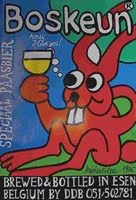Size: 330 ml
ABV: 11 %
This is the second and penultimate beer from the Kasteel range which has found its way down my throat. The first was the dark sweet cloying beast that is the Kasteel Donker (#93), where I had previously told the story of the history of the famous castle in Ingelmunster, up until 1986 when the brewing siblings Luc and Marc Van Honsebrouck moved in.
It hasn’t all been good news though since. In 2001 the beautiful moated building was devastated by a terrible fire. Work has been done ever since to restore the castle however so immense was the damage that at least two thirds are no longer open to the public. The structure does though remain, and has been bandaged up over the years to at least look better on the outside, but the heart and soul has literally been ripped out of this historic building. This is no better exemplified than by the loss of almost everything inside – family furniture, tapestries, sculptures and paintings all perished forever one September evening.
It also isn’t the first time that the castle has burnt down. This jinxed building and in fact the whole village of Ingelmunster was completely razed in 1695 following hostilities between English, French and Spanish soldiers. The rebuilding which followed under Hapsburg rule has led to the current design which has only just hung onto existence by the very skin of its teeth. In fact, the only area now safe for the public to enter is the Kasteelkelder, the atmospheric name for the castle’s basement. It is here where tourists and beer fans can enjoy tasting the famous Van Honsebrouck beers in their traditional castle shaped glasses.
The Kasteel Triple is another megalith of a beer. Weighing in at 11% you would need to ensure you had a designated driver if you were stopping in at Ingelmunster for a quick tipple. Somebody recently suggested to me that this beer is similar to the Bush Blonde (#164) by Dubuisson, and to be fair they aren’t too far wrong in terms of appearance and potency, however I feel the Kasteel Tripel has just a little more panache in the finish. There is some fruit in there, some spice and whatever that something is that just urges you to want another. This is by no means a professional ground-breaking brew, but it deserves its place as one of the better super-strength triples.








